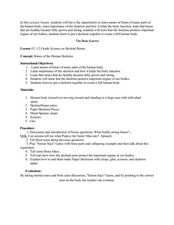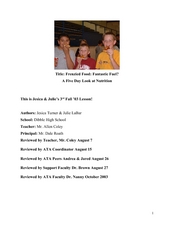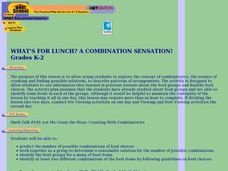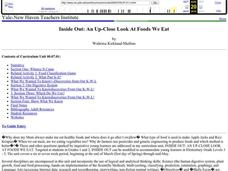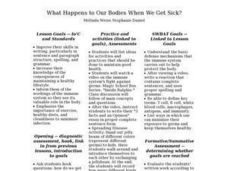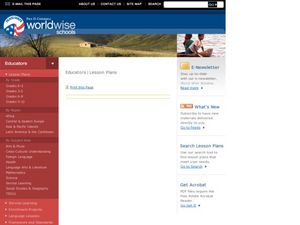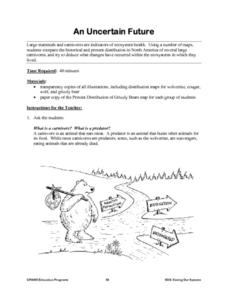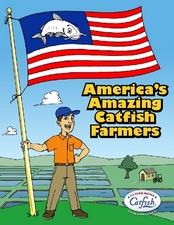Curated OER
Science
Students read labels of candy bars. In this ingredients lesson, students examine a variety of candy bar labels to determine the contents. Students research to find additional information on each candy bar, then write an opinion article...
Curated OER
Food and Digestion
In this food and digestion activity, students fill in the table for each food group. Students also complete a diagram illustrating the digestive system.
Curated OER
The Bone Known
Young scholars explore the human skeleton. In this biology lesson, students view a diagram of the human skeleton and identify the names of bones. Young scholars define the role bones play in protecting the human body and construct a...
Curated OER
Food Chain: what's for dinner?
Fourth graders identify where foods came from and sequence a food chain. In this food chain lesson, 4th graders define vocabulary related to food chains and order a food chain. Students follow the energy of a food chain. Students...
Curated OER
Dollar Value and Fast-Food Nutrition
Students examine how they can make changes to form healthy eating habits. In this investigative lesson students examine food guidelines and the food pyramid.
Curated OER
Nutrition
Fourth graders engage in an original unit about nutrition and record daily intake of food in order to help create a healthy eating plan. They practice making practical food choices for optimum health and then investigate how to maintain...
Curated OER
Frenzied Food: Fantastic Fuel?
Students infer the causes of obesity. In this health science lesson, students brainstorm ways improve to their diet. They write personalized journals with goals on how to live a healthy lifestyle.
Curated OER
What's For Lunch? A Combination Sensation!
Students combine different foods to make possible lunches and determine the specific combinations of lunches that can be made from a finite set of foods.
Curated OER
Inside Out: An Up-Close Look At Foods We Eat
Fourth graders identify the origins of meats and vegetables consumed by humans on a daily basis. They classify foods (meats, dairy products, grains...) and create a food pyramid.
Curated OER
Dietary Guidelines for Good Nutrition
Students examine Dietary Guidelines for Americans developed by United States Department of Agriculture, analyze their diets for three days, and determine if their diets met the recommended dietary allowances (RDA) for their age and sex.
Curated OER
The Six Nutrients Student Worksheet
In this health worksheet, students answer ten questions based around the concept of the different types of foods like carbohydrates, proteins, and fats with an emphasis upon how they are used in the body.
Curated OER
Mystery "F & V's"
Second graders explore a balanced diet. In this balanced diet lesson plan, 2nd graders investigate the effect and importance of a balanced diet.
Curated OER
What Happens to Our Bodies When We Get Sick?
Seventh graders explore ways in which they become sick. They find out ways that there bodies fight off bacteria. Students watch a video from the Magic School Bus series:"Inside Raphie." After reviewing video students can openly discuss...
Curated OER
Know your roots!
Looking at an image of plant systems with their roots in the ground, learners determine which would be the most or least difficult to pull. They write short sentences describing which plant they chose and why. Intended for 3rd or 4th...
Curated OER
Raw Seafood ~ On the Half Shell
The topic is fascinating, but there is not much for learners to do here. Food borne illness has always been a problem for humans to face, and here, data from the Center for Disease Control is analyzed. Learners look at the number of...
Curated OER
Windmills and Blogs: The Impact of Technology in Rural Peru
How does technology affect a community? Research the benefits and consequences of technology in rural Peru. In this technology lesson, learners discuss how the effects of technology. They view a PowerPoint and learn about the Peace...
Curated OER
Beef and Beef By-Products
Students examine the various types of beef and the many uses of its by-products. They increase their knowledge by playing a game of "beef bingo."They discuss what parts of beef animals are their by-products.
Curated OER
An Uncertain Future
Students study the distribution of large mammals and carnivores in an ecosystem. Using maps and historical data, they examine areas for these animals such as refuges, untouched forests, prairies and grasslands. Students determine actions...
Curated OER
Catfish Coloring Book
In this catfish coloring book instructional activity, students read information about catfish and color pictures in a twenty-page coloring book. Final page contains recipes.
BBC
Sorting and Using Materials
First and second graders see that everyday objects are made from a variety of materials. They interact with objects such as keys, plastic spoons, a wooden ruler, a towel, and a plastic bag. A discussion ensues which leads them to...
Curated OER
Home Sweet Home
Students explore marine turtle habitats. Students research one species of marine turtle found in the Gulf of Mexico. They identify plants and animals in the habitat. They create a model or replica using information gathered through their...
Curated OER
What's on Your Plate?
Young scholars analyze the calorie content of food. In this health science lesson, students discuss how excess calories affect our body. They write a healthy meal plan for their family.
Curated OER
Perceived Overweight and Actual Weight Risk Classification
Students calculate their BMI and compare it to a healthy weight chart. In this health lesson, students compare the perception of overweight with healthy weight charts. Students interpret collected data and evaluate their own weight...
Curated OER
"Mush Lab"
Students use the information they learned from reading food labels to create mush meals. They blend unlikely meals together to form the mush and then evaluate its nutritional value. They examine their own eating habits after the lab is...




